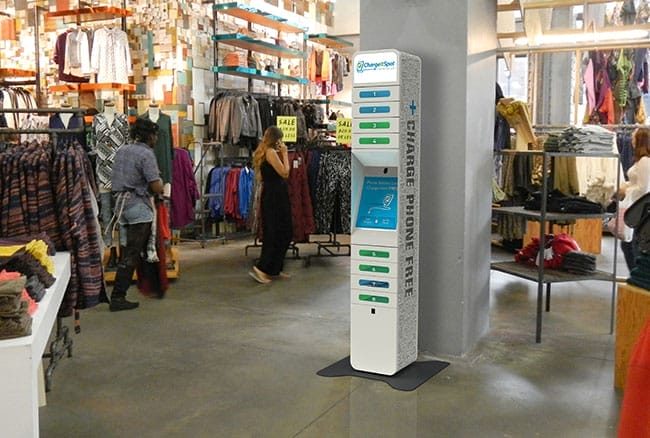Doug Baldasare, WG’12, laughs now about the first time he delivered a ChargeItSpot machine, Aug. 12, 2012, to the Whole Foods market in Jenkintown, a suburb of Philadelphia. He pulled up in a rented Ford Fusion, lugged the machine into place, and waited and hoped for the first customer interaction—any interaction. In the first six hours, more than 50 people engaged with the kiosk. Since, Baldasare has forged partnerships with local retailers such as Urban Outfitters, and he’s conducted informal research to prove correlation between charging phones in-store and sales (including shadowing customers in-store and taking notes himself). But Baldasare needed confirmation—if you give consumers a place to charge their mobile devices, securely and for free, will they shop longer and spend more?
He now has it thanks to a recently completed market research study carried out by international market research firm GfK. According to the findings, users of the ChargeItSpot kiosks spent 115 percent more time in stores, made a purchase 54 percent more frequently and spent 29 percent more per transaction than people who couldn’t access the machines. That equates to $219 per day in more sales for a retailer per ChargeItSpot machine, or $79,793 per year.The trick to the survey was proving causality. GfK did this by only studying people who tried to use the ChargeItSpot device; randomly, people were either allowed to charge their phone, or received a message telling them the device was full and unavailable. Baldasare credits Wharton’s Frances and Pei-Yuan Chia Professor of Marketing Peter Fader and former executive director of the Wharton Customer Analytics Initiative, Elea Feit, C’94, for helping to design the study.
“This study has given us a huge momentum with retailers,” Baldasare says.

Doug Baldasare, WG’12
He is hoping for momentum, in particular, with national retailers—the kind that can place ChargeItSpots in tens of thousands of stores around the country. It’s a long way from that first Whole Foods and for a company launched in 2012 with the assistance of the Wharton Entrepreneurship Venture Initiation Program.
To make that leap in scale, Baldasare needs more than the research. The ChargeItSpot devices have also gone through an evolution. Early models were free standing and bare in appearance so retailers could move and brand them at will, and they looked and functioned similar to the lock-and-key lockers that people store car keys and loose change at gyms. The latest models are accessed through a 17-inch touch screen, and users enter their phone number as the digital key. The underlying software has been upgraded and made scalable, and the interface can be customized to offer users prompts (to buy more) or to collect additional data (say, for retailer loyalty reward programs). The machines also have speakers and microphones so that remote ChargeItSpot attendants can assist with snafus like trapped devices. The newest kiosks connect with the Internet through 4G wireless.
Baldasare is building out his team, as well, with pros from the retail and kiosk world, as well as with additional salespeople, to be poised for what’s next.
As for your author, I am poised to find a coffee shop where I can charge my phone while I grab a caffeinated beverage. Luckily for me, the Hubbub across Spruce Street has a ChargeItSpot.

























